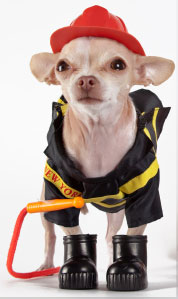Do you know how you would save your pet in the event of a house fire? Did you ever imagine that your pet could actually be the cause? An estimated 500,000 pets are affected annually by home fires and a new data analysis by the National Fire Protection Association shows that 1,000 house fires each year are accidentally started by the homeowners’ pets. Those numbers seem surprising at first, but when you think about common behavioral problems like stealing food from a stove top or excitedly knocking into objects it is easy to see how a fire could be started. To spread awareness on this topic, the American Kennel Club and ADT Security Services have joined forces for the third annual National Pet Fire Safety Day.
"Not many pet owners realize that their pet can actually be the cause of a devastating fire," AKC spokesperson Lisa Peterson said in a statement. "Simple preventative measures, such as flameless candles and stove knob covers can mean the difference between life and death for your four-legged friends."
Chris and Kay Wardlow of Oklahoma know that all too well. Their curious dog Lucy was home alone and spied a cake on the stove top. As Lucy tried to get a taste, her paw accidentally hit the stove knob and turned on the gas burner that was under the cake pan. Within minutes, the house was filled with smoke, triggering the Wardlow’s ADT monitored smoke detector. Firefighters were called to the scene, the house was saved and Lucy was rescued.
Here are some tips to prevent your pet from starting a fire:
- Extinguish open flames - Pets are generally curious and will investigate cooking appliances, candles, and even fires in your fireplace. Ensure your pet is not left unattended around an open flame and make sure to thoroughly extinguish any open flame before leaving your home.
- Remove stove knobs - Be sure to remove stove knobs or protect them with covers before leaving the house. According to the National Fire Protection Association, a stove or cook top is the number one piece of equipment involved in your pet starting a fire.
- Invest in flameless candles – These candles contain a light bulb rather than an open flame, and take the danger out of your pet knocking over a candle. Cats are notorious for starting fires when their tails turn over lit candles.
- Beware of water bowls on decks – Do not leave a glass water bowl for your pet outside on a wooden deck. The sun's rays when filtered through the glass and water can actually heat up and ignite the wooden deck beneath it. Choose stainless steel or ceramic bowls instead.
Keep your pets safe:
- Keep pets near entrances when away from home – Keep collars on pets and leashes at the ready in case firefighters need to rescue your pet. When leaving pets home alone, keep them in areas or rooms near entrances where firefighters can easily find them.
- Secure young pets – Especially with young puppies, keep them confined away from potential fire-starting hazards when you are away from home such as in crates or behind baby gates in secure areas.
- Consider using monitored smoke detectors — Monitors that are connected to a monitoring center alert emergency responders, which is critical when you’re not home. These systems provide an added layer of protection beyond battery-operated smoke alarms.
- Affix a pet alert window cling -- The groups are also urge pet owners to get window clings for their home. Write down the number of pets inside your house and attach the static cling to a front window so that the fire/rescue crew can see it. This critical information saves rescuers time when locating your pets. Make sure to update the number of pets listed.
In partnership with the National Volunteer Fire Council, pet owners can obtain a free Pet Fire Safety Window Cling on National Pet Fire Safety Day. For a list of locations, visit www.nvfc.org/windowclings. The clings are also free online at www.adt.com/pets.

